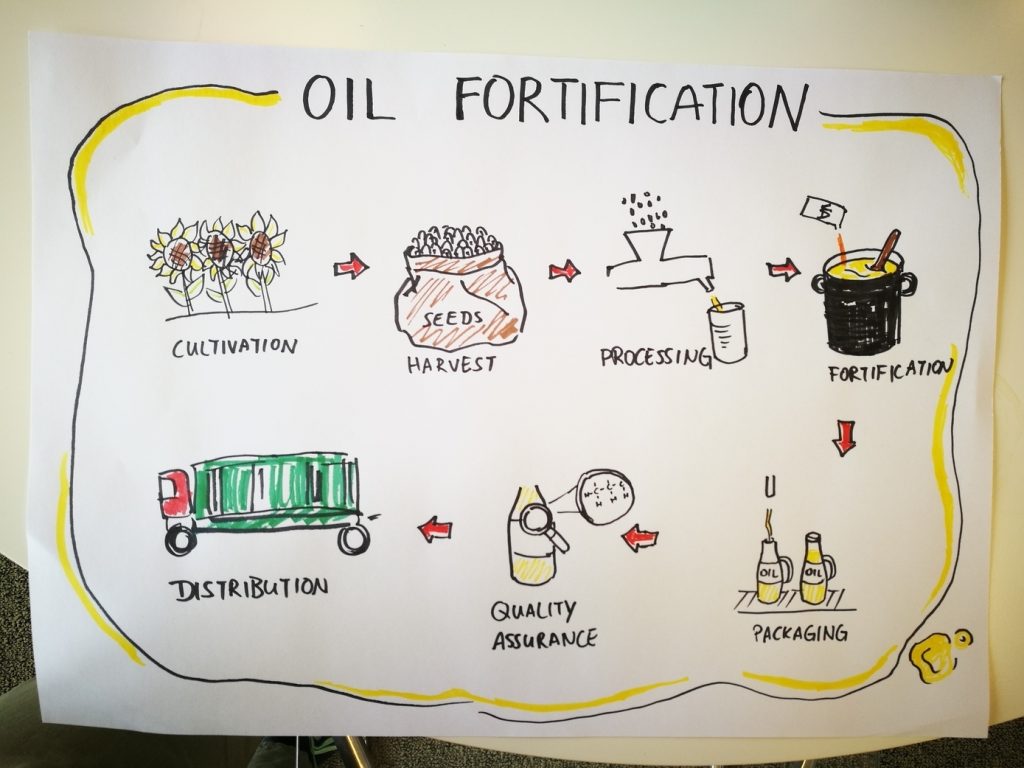Over the last month, I have been busy with the next stages of my project, which are data collection and doing the assessment of the climate change impacts of the fortificants value chains I am studying.
The methodology I am using for my assessment is called Life Cycle Assessment (LCA), which considers the potential environmental impacts associated with a product. The impacts are calculated for all stages of production (‘life cycle’), from the acquisition of raw materials up until the distribution or recycling stage of whatever waste material is left (Klopfer & Grahl). For food fortification value chains, the life cycle would start at the crop production stage and end when the packaged and fortified food is distributed to the consumers.

Many different environmental impacts can be assessed through LCA, such as biodiversity, global warming (in terms of global warming potential), ozone depletion, eutrophication (excess amount of nutrients and minerals in a body of water, which may lead to increased algal and plant growth and decrease oxygen content, as well as thus quality among others) and land use. One impact category can be the sum of many factors added together, e.g., when several greenhouse gases which contribute to global warming are examined. Because the ability absorb infrared and reflecting them back to the earth of, say, nitrogen oxide and methane, are higher than CO2, they are expressed in CO2 equivalents for ease of comparison. The environmental impacts are ‘potential’ environmental impacts because the fates of pollutants or greenhouse gases may differ based on the system studied and therefore the severity of impacts may vary.
The framework for doing LCAs are outlined in internationally determined standards (ISO 14040 and ISO1 4041) and are as follows:
• Goal and scope:
Decide what the purpose of your life cycle assessment is, and what product(s) you want to find the impacts for
• Life cycle inventory:
Gather data for all the materials that go into production (inputs), main and co-products from the production process (co-products), and waste materials. This can include anything from energy, fuel, and water to other natural resources and chemicals.
• Life cycle inventory assessment:
Evaluate questions such as, “What are the environmental impacts associated with each of the inputs and outputs from the inventory? Are there any gaps or uncertainties to be aware of?”
• Interpretation:
Evaluate results and try to answer the question(s) posed in goal and scope.
There are certainly advantages and disadvantages related to using the LCA approach. The most important aspects are listed in the table below:
Advantages and disadvantages of the LCA approach (from Curran, 2014)
Advantages
-Comprehensiveness: LCA looks at the entire life cycle of a product rather than only a select few processes
-Challenges conventional wisdom and assumptions
-Standardized framework
Disadvantages
-Does not include socio-economic impacts and factors
-Accuracy of results depends on the completeness of inventory and data quality
-Time-consuming and costly
Personally, LCA made me re-think how my day-to-day actions affect my carbon footprint. For example, I usually refrain from printing out reading material for my studies and thesis whenever I can, as I thought less paper consumption would result in fewer trees being cut down. So I usually read journal articles on-screen. However, if one compares the usage necessary for one hour of reading the material, for screen-reading one would need to take into account the electricity consumption of a computer, as well as the resources and energy required to manufacture the computer, and for it to reach the consumer (me). As for printed materials, one would need to consider all the resources, energy use, etc., to produce the printed pages of paper. If I need to re-read the document numerous times, the benefits of reading journals on-screen seem especially less clear-cut, as I would repeatedly consume electricity to operate the computer, whereas the impacts of the paper document would be restricted to its production and printing.
Here is a LCA report related to this particular comparison for anyone interested in finding out more:
References CURRAN, M. A. 2014. Strengths and Limitations of Life Cycle Assessment. In: KLÖPFFER, W. (ed.) Background and Future Prospects in Life Cycle Assessment. Dordrecht: Springer Netherlands.
KLÖPFFER, W. & GRAHL, B. 2014. Life cycle assessment (LCA): a guide to best practice, John Wiley & Sons.